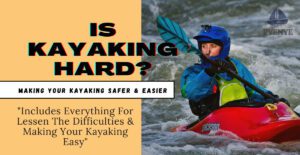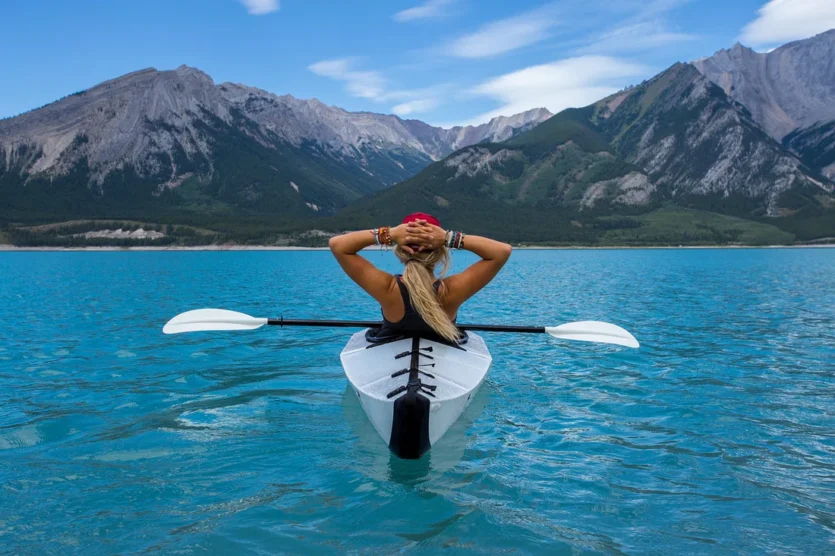
So, you’ve decided to give kayaking a try, huh? Good choice! It’s an awesome way to connect with nature, get a little workout, and explore the beauty of rivers, lakes, or even the open sea. But, before you grab a paddle and hop into a kayak, there are a few things you should know to make the experience smooth and fun.
I’ve been there as a beginner, with a mix of excitement and nerves, so I’m here to help you feel confident about your first kayaking adventure.
Let’s break it down step by step, so you’ll know exactly what to expect and how to prepare.
Jump To A Section
How to Pick the Right Kayak
First thing’s first ─ You need a kayak. But here’s the thing, not all kayaks are created equal. For beginners, it’s best to start with a recreational kayak. They’re stable, easy to maneuver, and great for calm waters like lakes or slow-moving rivers.
You don’t want to jump straight into a sleek, professional kayak for whitewater adventures just yet.
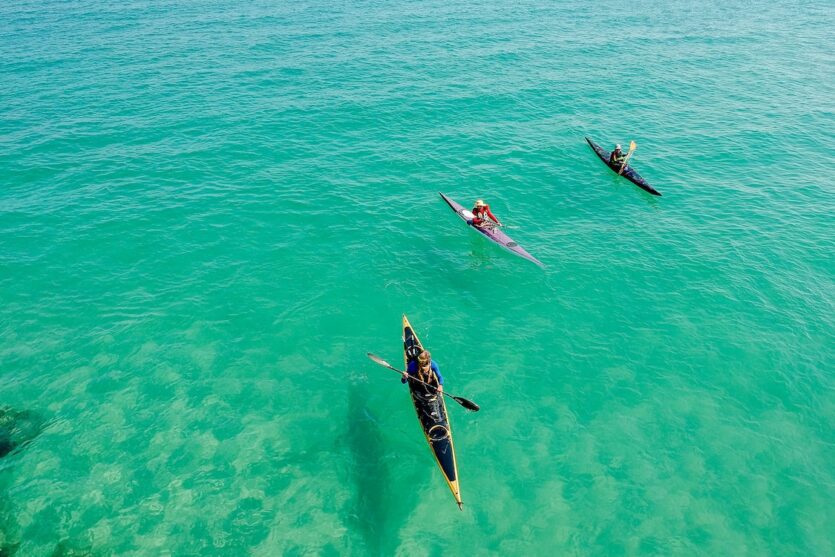
Key Types of Kayaks for Beginners
| Kayak Type | Advantages | Disadvantages |
| Sit-on-top kayaks | Wide, stable, easy to get in and out of, perfect for beginners, easy to re-enter after tipping over | Can feel too open for some, exposure to the elements |
| Sit-in kayaks | More control and protection from the elements, better for cooler weather, keeps you dry | Can feel claustrophobic, harder to exit if tipped over |
| Inflatable kayaks | Durable, easy to transport, great for those with limited storage space | Not as sturdy as hard-shell kayaks |
Note: Whatever type you choose, make sure it fits your body comfortably. You don’t want something too big or too small. Your legs should have a bit of room, and you should feel balanced when sitting in the kayak.
Essential Gear
The right gear makes all the difference. Trust me, you don’t want to skimp on this stuff. Safety is key, but comfort is just as important. Must-have kayaking gear includes:
- Personal flotation device (PFD) ─ Yep, a life jacket. No matter how confident you are in your swimming skills, wearing a PFD is a non-negotiable. Not only is it often required by law, but it’s a lifesaver if you tip over or get tired in the water.
- Paddle ─ Your paddle should be the right length for your height and kayak. A good rule of thumb: hold the paddle over your head, and your arms should form a 90-degree angle when gripping it. A paddle that’s too short or too long will make the whole experience tougher than it needs to be.
- Dry bag ─ Keep your essentials (phone, keys, snacks) safe from the water. Trust me, a soaked sandwich is not fun.
- Sun protection ─ Being on the water means extra exposure to the sun. A hat, sunglasses, and sunscreen are your best friends here.
- Appropriate clothing ─ Dress for the water temperature, not just the air. Quick-drying clothes, water shoes, and layers if it’s cool out are smart choices. Cotton is a no-go—it stays wet and heavy.
- Whistle or signal device ─ It’s always a good idea to have something to signal for help, just in case.
Which Techniques Do You Need to Know?
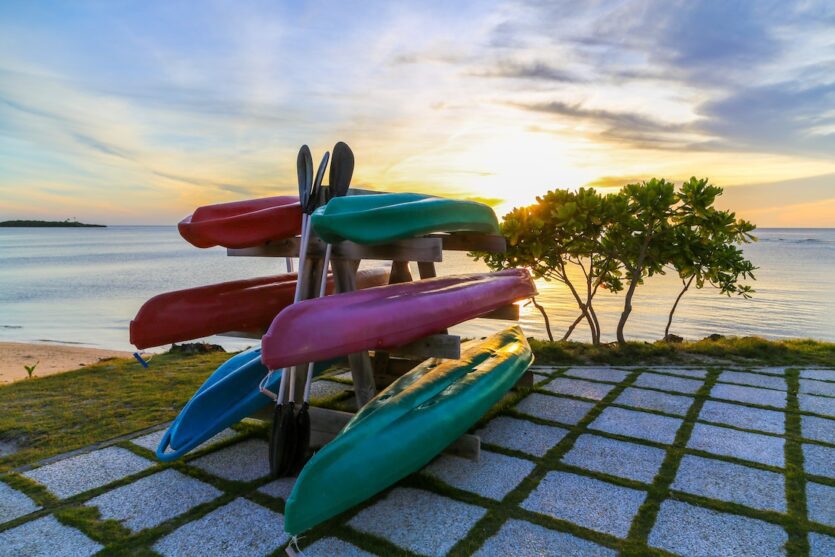
Paddling isn’t as simple as just sticking your paddle in the water and going for it—there’s a bit of technique involved.
| Stroke Type | Description |
| Forward Stroke |
*Use your core to avoid tiring quickly. |
| Sweep Stroke |
|
| Reverse Stroke | For moving backward or stopping, push the paddle forward in the water instead of pulling. |
Start slowly. You’ll want to get a feel for how the kayak moves in response to each stroke.
Safety Tips You Should Know
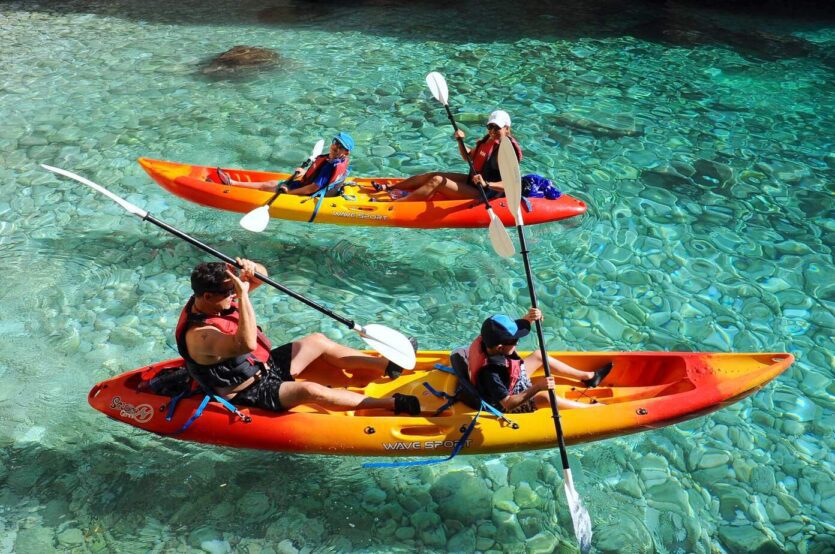
I remember feeling a little uneasy my first time out on the water, but with some key safety practices in place, I quickly relaxed and enjoyed the experience.
Check the Weather In Advance
Calm waters are ideal for beginners, so avoid windy or stormy conditions. Even if the day looks nice, check the forecast, especially if you’re heading into open waters where conditions can change quickly.
Know Your Limits
It’s easy to get overexcited and paddle farther than you intended. Start with short trips and stay close to shore until you’re comfortable.
Stay Hydrated
Being on the water under the sun can dehydrate you quickly. Bring plenty of water and drink often.
Learn How to Exit a Kayak
If you flip over (and it’s likely to happen at some point), stay calm. If you’re in a sit-on-top kayak, it’s as simple as flipping it back over and climbing on. For sit-in kayaks, you’ll need to practice a “wet exit,” which involves sliding out from under the overturned kayak. Practice this in shallow water before venturing out.
Buddy Up!
Solo kayaking is peaceful, but it’s safer (and more fun) with a friend, especially as a beginner.
How to Choose Your First Kayaking Destination
Your first kayaking trip should be enjoyable, not stressful. Choosing the right location is half the battle. You want calm, flat water with minimal current. Lakes, slow rivers, and sheltered bays are all great options.
I wouldn’t recommend the open ocean or rivers with rapids just yet—those can wait until you’ve got more experience under your belt.
Get Comfortable with Your Kayak
Before you set off, take a moment to get comfortable in your kayak. Practice sitting in it while it’s still on land—this will give you a sense of balance before you’re on the water. Once you’re in, take some time to adjust your foot pegs (most kayaks have these). Your feet should be braced against them when paddling.
When you first get on the water, stick close to the shore until you feel confident. Paddle around in a small circle, test out your strokes, and get used to the way the kayak moves. It’s normal to feel a little unsteady at first, but you’ll quickly find your balance.
Stay out of the way of bigger boats! Boats usually have the right of way, so keep your distance and avoid paddling in their direct path.
Wrapping It Up
Your first time kayaking might feel a little overwhelming at first, but with the right gear, a bit of practice, and a focus on safety, you’ll be gliding across the water in no time. Who knows? You might just find yourself hooked on this awesome outdoor activity.
